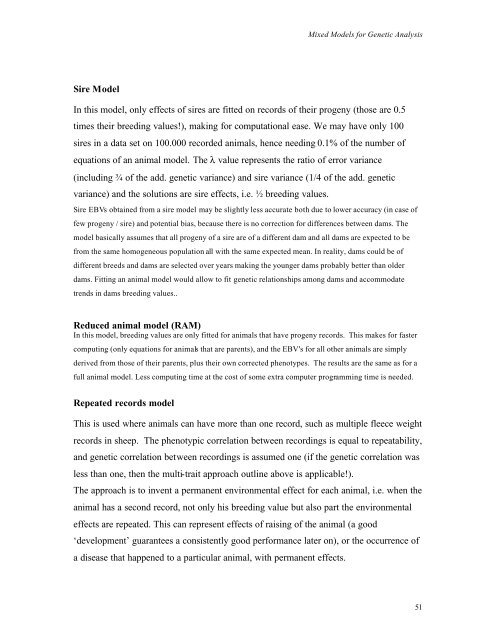Mixed Models for Genetic analysis
Mixed Models for Genetic analysis
Mixed Models for Genetic analysis
Create successful ePaper yourself
Turn your PDF publications into a flip-book with our unique Google optimized e-Paper software.
<strong>Mixed</strong> <strong>Models</strong> <strong>for</strong> <strong>Genetic</strong> AnalysisSire ModelIn this model, only effects of sires are fitted on records of their progeny (those are 0.5times their breeding values!), making <strong>for</strong> computational ease. We may have only 100sires in a data set on 100.000 recorded animals, hence needing 0.1% of the number ofequations of an animal model. The λ value represents the ratio of error variance(including ¾ of the add. genetic variance) and sire variance (1/4 of the add. geneticvariance) and the solutions are sire effects, i.e. ½ breeding values.Sire EBVs obtained from a sire model may be slightly less accurate both due to lower accuracy (in case offew progeny / sire) and potential bias, because there is no correction <strong>for</strong> differences between dams. Themodel basically assumes that all progeny of a sire are of a different dam and all dams are expected to befrom the same homogeneous population all with the same expected mean. In reality, dams could be ofdifferent breeds and dams are selected over years making the younger dams probably better than olderdams. Fitting an animal model would allow to fit genetic relationships among dams and accommodatetrends in dams breeding values..Reduced animal model (RAM)In this model, breeding values are only fitted <strong>for</strong> animals that have progeny records. This makes <strong>for</strong> fastercomputing (only equations <strong>for</strong> animals that are parents), and the EBV's <strong>for</strong> all other animals are simplyderived from those of their parents, plus their own corrected phenotypes. The results are the same as <strong>for</strong> afull animal model. Less computing time at the cost of some extra computer programming time is needed.Repeated records modelThis is used where animals can have more than one record, such as multiple fleece weightrecords in sheep. The phenotypic correlation between recordings is equal to repeatability,and genetic correlation between recordings is assumed one (if the genetic correlation wasless than one, then the multi-trait approach outline above is applicable!).The approach is to invent a permanent environmental effect <strong>for</strong> each animal, i.e. when theanimal has a second record, not only his breeding value but also part the environmentaleffects are repeated. This can represent effects of raising of the animal (a good‘development’ guarantees a consistently good per<strong>for</strong>mance later on), or the occurrence ofa disease that happened to a particular animal, with permanent effects.51
















